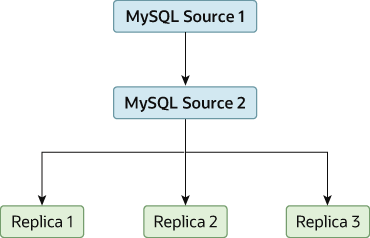As the number of replicas connecting to a source increases, the load, although minimal, also increases, as each replica uses a client connection to the source. Also, as each replica must receive a full copy of the source's binary log, the network load on the source may also increase and create a bottleneck.
If you are using a large number of replicas connected to one source, and that source is also busy processing requests (for example, as part of a scale-out solution), then you may want to improve the performance of the replication process.
One way to improve the performance of the replication process is to create a deeper replication structure that enables the source to replicate to only one replica, and for the remaining replicas to connect to this primary replica for their individual replication requirements. A sample of this structure is shown in Figure 19.3, “Using an Additional Replication Source to Improve Performance”.
For this to work, you must configure the MySQL instances as follows:
Source 1 is the primary source where all changes and updates are written to the database. Binary logging is enabled on both source servers, which is the default.
Source 2 is the replica to the server Source 1 that provides the replication functionality to the remainder of the replicas in the replication structure. Source 2 is the only machine permitted to connect to Source 1. Source 2 has the
--log-replica-updatesoption enabled (the default). With this option, replication instructions from Source 1 are also written to Source 2's binary log so that they can then be replicated to the true replicas.Replica 1, Replica 2, and Replica 3 act as replicas to Source 2, and replicate the information from Source 2, which actually consists of the upgrades logged on Source 1.
The above solution reduces the client load and the network interface load on the primary source, which should improve the overall performance of the primary source when used as a direct database solution.
If your replicas are having trouble keeping up with the replication process on the source, there are a number of options available:
If possible, put the relay logs and the data files on different physical drives. To do this, set the
relay_logsystem variable to specify the location of the relay log.If heavy disk I/O activity for reads of the binary log file and relay log files is an issue, consider increasing the value of the
rpl_read_sizesystem variable. This system variable controls the minimum amount of data read from the log files, and increasing it might reduce file reads and I/O stalls when the file data is not currently cached by the operating system. Note that a buffer the size of this value is allocated for each thread that reads from the binary log and relay log files, including dump threads on sources and coordinator threads on replicas. Setting a large value might therefore have an impact on memory consumption for servers.If the replicas are significantly slower than the source, you may want to divide up the responsibility for replicating different databases to different replicas. See Section 19.4.6, “Replicating Different Databases to Different Replicas”.
If your source makes use of transactions and you are not concerned about transaction support on your replicas, use
MyISAMor another nontransactional engine on the replicas. See Section 19.4.4, “Using Replication with Different Source and Replica Storage Engines”.If your replicas are not acting as sources, and you have a potential solution in place to ensure that you can bring up a source in the event of failure, then you can disable
log_replica_updates. This prevents “dumb” replicas from also logging events they have executed into their own binary log.
